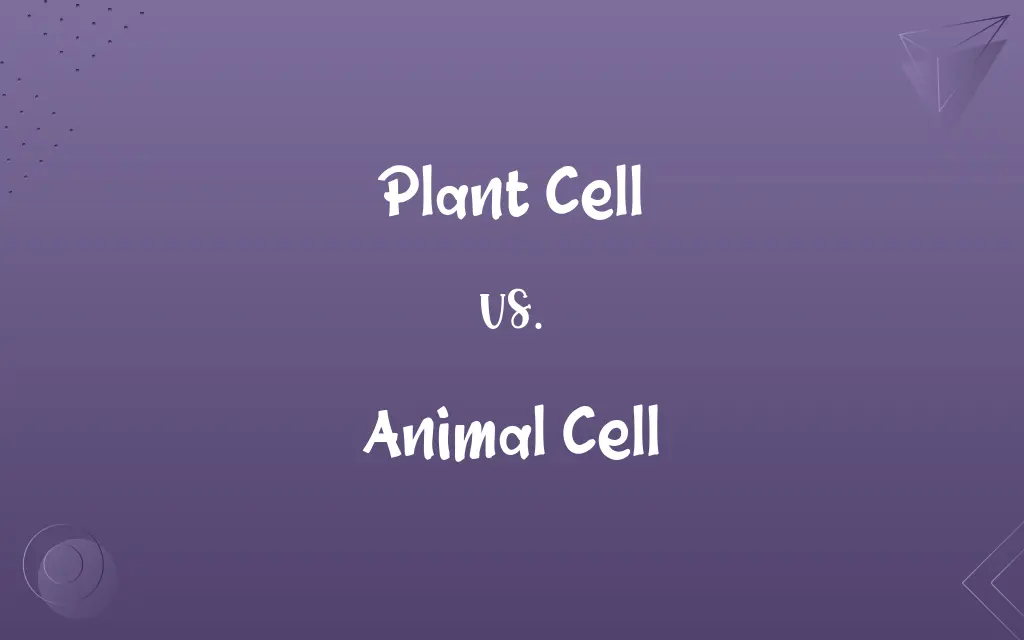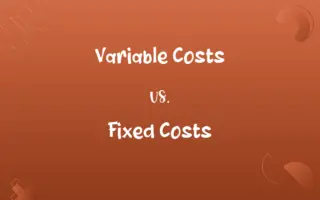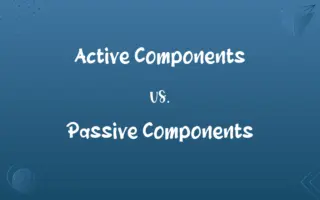Plant Cell vs. Animal Cell: Know the Difference

By Shumaila Saeed || Updated on December 25, 2023
Plant cells have a cell wall and chloroplasts for photosynthesis, while animal cells lack these but have centrioles.

Key Differences
Plant cells are typically larger and have a rigid cell wall made of cellulose, which gives them a fixed rectangular shape. Animal cells, on the other hand, are smaller, lack a cell wall, and have a more flexible and varied shape. This fundamental difference in structure affects how these cells interact with their environment.
Shumaila Saeed
Dec 10, 2023
Plant cells contain chloroplasts, the site of photosynthesis, where sunlight is converted into energy. Animal cells do not have chloroplasts. Instead, they rely on mitochondria for energy production through a process called cellular respiration, which is also present in plant cells.
Shumaila Saeed
Dec 10, 2023
Plant cells often have large central vacuoles that store water, nutrients, and waste products. In contrast, animal cells may have smaller vacuoles or sometimes none at all. The large central vacuole in plant cells also helps in maintaining cell rigidity.
Shumaila Saeed
Dec 10, 2023
Plant cells can reproduce both sexually and asexually, and are capable of generating an entire plant from a single cell under the right conditions. Animal cells typically reproduce sexually, and a single cell cannot grow into a complete organism.
Shumaila Saeed
Dec 10, 2023
During cell division, plant cells form a cell plate that eventually becomes the cell wall, separating the two daughter cells. Animal cells, however, undergo cytokinesis, where the cell membrane pinches in to divide the daughter cells.
Shumaila Saeed
Dec 10, 2023
ADVERTISEMENT
Comparison Chart
ADVERTISEMENT
Plant Cell and Animal Cell Definitions
Plant Cell
A plant cell contains a large central vacuole for storage and maintaining rigidity.
The central vacuole in a plant cell stores water, contributing to the turgidity of the plant.
Shumaila Saeed
Dec 02, 2023
Animal Cell
Animal cells often have smaller and more vacuoles than plant cells.
The small vacuoles in an animal cell store nutrients, waste products, and other substances.
Shumaila Saeed
Dec 02, 2023
Plant Cell
A plant cell can perform photosynthesis, converting light energy into chemical energy.
The plant cell absorbs sunlight to produce glucose and oxygen in its chloroplasts.
Shumaila Saeed
Dec 02, 2023
Animal Cell
Animal cells have a flexible cell membrane, allowing for a variety of shapes.
The ability of an animal cell to change shape is essential for the functioning of many types of cells, like neurons and muscle cells.
Shumaila Saeed
Dec 02, 2023
Plant Cell
Plant cells have a rigid cell wall that provides structural support and shape.
The firm texture of a leaf is due to the cell walls in each plant cell.
Shumaila Saeed
Dec 02, 2023
ADVERTISEMENT
Animal Cell
An animal cell is the basic structural and functional unit of animals, lacking a cell wall.
The flexibility of an animal's body is partly due to the lack of a rigid cell wall in animal cells.
Shumaila Saeed
Dec 02, 2023
Plant Cell
Plant cells have plasmodesmata, channels allowing communication and transport between cells.
Nutrients are distributed throughout the plant through the plasmodesmata in plant cells.
Shumaila Saeed
Dec 02, 2023
Animal Cell
Animal cells contain centrioles, important for cell division and reproduction.
During cell division, the centrioles in an animal cell play a crucial role in the formation of the spindle fibers.
Shumaila Saeed
Dec 02, 2023
Plant Cell
A plant cell is the basic structural and functional unit of plants, containing chloroplasts.
In photosynthesis, the plant cell uses its chloroplasts to convert sunlight into energy.
Shumaila Saeed
Dec 02, 2023
Animal Cell
Animal cells rely on mitochondria for energy production through cellular respiration.
The mitochondria in an animal cell convert glucose into ATP, providing energy for cellular functions.
Shumaila Saeed
Dec 02, 2023
Repeatedly Asked Queries
Do animal cells have chloroplasts?
No, animal cells do not have chloroplasts; they rely on mitochondria for energy.
Shumaila Saeed
Dec 10, 2023
How do plant and animal cells differ in energy production?
Plant cells use chloroplasts for photosynthesis, while animal cells use mitochondria for cellular respiration.
Shumaila Saeed
Dec 10, 2023
What is unique about the cell wall in plant cells?
The cell wall in plant cells is made of cellulose and provides rigidity and structural support.
Shumaila Saeed
Dec 10, 2023
How do plant cells reproduce?
Plant cells can reproduce both sexually and asexually, and are capable of regenerating an entire plant.
Shumaila Saeed
Dec 10, 2023
Can plant cells change shape like animal cells?
Generally, plant cells have a fixed shape due to their rigid cell wall.
Shumaila Saeed
Dec 10, 2023
What role do vacuoles play in plant and animal cells?
In plant cells, vacuoles store water and maintain rigidity; in animal cells, they store nutrients and waste.
Shumaila Saeed
Dec 10, 2023
What is the role of centrioles in animal cells?
Centrioles are involved in cell division and help in forming spindle fibers.
Shumaila Saeed
Dec 10, 2023
What is the main function of a plant cell?
The main function of a plant cell is to perform photosynthesis and provide structural support to the plant.
Shumaila Saeed
Dec 10, 2023
Do animal cells perform photosynthesis?
No, animal cells do not perform photosynthesis; this is a function unique to plant cells.
Shumaila Saeed
Dec 10, 2023
Are plant cells bigger than animal cells?
Generally, plant cells are larger than animal cells.
Shumaila Saeed
Dec 10, 2023
Do animal cells have a central vacuole?
No, animal cells may have smaller vacuoles or sometimes none at all.
Shumaila Saeed
Dec 10, 2023
Can plant cells adapt their shape?
Plant cells have a fixed shape due to their rigid cell wall.
Shumaila Saeed
Dec 10, 2023
Why do plant cells have a large central vacuole?
The large central vacuole in plant cells helps in storing nutrients and maintaining cell rigidity.
Shumaila Saeed
Dec 10, 2023
Can a single animal cell grow into a complete organism?
No, a single animal cell cannot grow into a complete organism, unlike some plant cells.
Shumaila Saeed
Dec 10, 2023
What differentiates the cell division process in plant and animal cells?
Plant cells form a cell plate during division, while animal cells undergo cytokinesis with a cleavage furrow.
Shumaila Saeed
Dec 10, 2023
Is the cellular respiration process the same in plant and animal cells?
Yes, both plant and animal cells use mitochondria for cellular respiration.
Shumaila Saeed
Dec 10, 2023
How do animal cells maintain their shape?
Animal cells maintain their shape through a flexible cell membrane and cytoskeleton structure.
Shumaila Saeed
Dec 10, 2023
Do plant and animal cells have different genetic material?
Both plant and animal cells contain DNA, but the organization and some genetic sequences differ.
Shumaila Saeed
Dec 10, 2023
What are plasmodesmata in plant cells?
Plasmodesmata are channels in plant cells that allow communication and substance exchange between cells.
Shumaila Saeed
Dec 10, 2023
Are mitochondria present in plant cells?
Yes, mitochondria are present in plant cells and are involved in energy production.
Shumaila Saeed
Dec 10, 2023
Share this page
Link for your blog / website
HTML
Link to share via messenger
About Author
Written by
Shumaila SaeedShumaila Saeed, an expert content creator with 6 years of experience, specializes in distilling complex topics into easily digestible comparisons, shining a light on the nuances that both inform and educate readers with clarity and accuracy.








































































